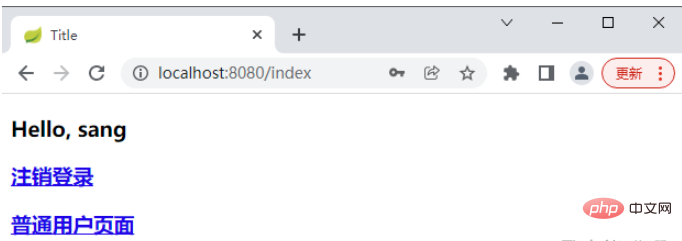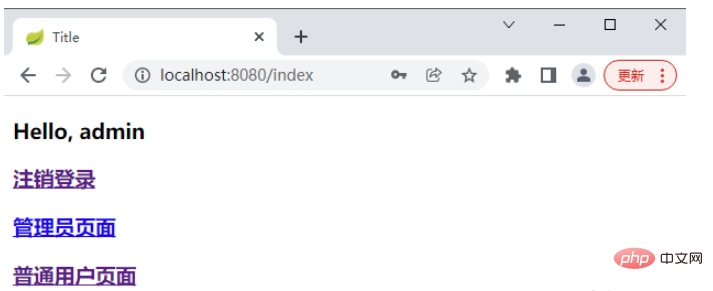SpringBoot安全管理之Shiro框架怎么使用
Shiro 简介
Apache Shiro 是一个开源的轻量级的 Java 安全框架,它提供身份验证、授权、密码管理以及会话管理等功能。相对于 Spring Security ,Shiro 框架更加直观、易用,同时也能提供健壮的安全性。
在传统的 SSM 框架中,手动整合 Shiro 的配置步骤还是比较多的,针对 Spring Boot ,Shiro 官方提供了 shiro-spring-boot-web-starter 用来简化 Shiro 在 Spring Boot 中的配置。
整合 Shiro
1. 创建项目
首先创建一个普通的 Spring Boot Web 项目,添加 Shiro 依赖以及页面模板依赖
<dependency> <groupId>org.apache.shiro</groupId> <artifactId>shiro-spring-boot-web-starter</artifactId> <version>1.4.0</version> </dependency> <dependency> <groupId>org.springframework.boot</groupId> <artifactId>spring-boot-starter-thymeleaf</artifactId> </dependency> <dependency> <groupId>com.github.theborakompanioni</groupId> <artifactId>thymeleaf-extras-shiro</artifactId> <version>2.0.0</version> </dependency>
这里不需要添加 spring-boot-starter-web 依赖,shiro-spring-boot-web-starter 中已经依赖了 spring-boot-starter-web 。同时,此处使用 Thymeleaf 模板,为了在 Thymeleaf 使用 shiro 标签,加入了 thymeleaf-extras-shiro 依赖。
2. Shiro基本配置
在 application.properties 中配置 Shiro 的基本信息
# 开启 Shiro 配置,默认为 true
shiro.enabled=true
# 开启 Shiro Web 配置,默认为 true
shiro.web.enabled=true
# 配置登录地址,默认为 /login.jsp
shiro.loginUrl=/login
# 配置登录成功的地址,默认为 /
shiro.successUrl=/index
# 未获授权默认跳转地址
shiro.unauthorizedUrl=/unauthorized
# 是否允许通过 URL 参数实现会话跟踪,如果网站支持 Cookie,可以关闭此选项,默认为 true
shiro.sessionManager.sessionIdUrlRewritingEnabled=true
# 是否允许通过 Cookie 实现会话跟踪,默认为 true
shiro.sessionManager.sessionIdCookieEnabled=true
然后在 Java 代码中配置 Shiro ,提供两个最基本的 Bean 即可
@Configuration
public class ShiroConfig {
@Bean
public Realm realm() {
TextConfigurationRealm realm = new TextConfigurationRealm();
realm.setUserDefinitions("sang=123,user\n admin=123,admin");
realm.setRoleDefinitions("admin=read,write\n user=read");
return realm;
}
@Bean
public ShiroFilterChainDefinition shiroFilterChainDefinition() {
DefaultShiroFilterChainDefinition chainDefinition =
new DefaultShiroFilterChainDefinition();
chainDefinition.addPathDefinition("/login", "anon");
chainDefinition.addPathDefinition("/doLogin", "anon");
chainDefinition.addPathDefinition("/logout", "logout");
chainDefinition.addPathDefinition("/**", "authc");
return chainDefinition;
}
@Bean
public ShiroDialect shiroDialect() {
return new ShiroDialect();
}
}代码解释:
这里提供两个关键的 Bean ,一个是 Realm,另一个是 ShiroFilterChainDefinition 。至于 ShiroDialect 则是为了支持在 Thymeleaf 中使用 Shiro 标签,如果不在 Thymeleaf 中使用 Shiro 标签,那么可以不提供 ShiroDialect
Realm 可以是自定义的 Realm,也可以是 Shiro 提供的 Realm,简单起见,此处没有配置数据库连接,直接配置了两个用户:sang/123 和 admin/123 ,分别对应角色 user 和 admin。
ShiroFilterChainDefinition Bean 中配置了基本的过滤规则 ,“/login” 和 “/doLogin”,可以匿名访问,“/logout”是一个注销登录请求,其余请求则都需要认证后才能访问
然后配置登录接口以及页面访问接口
@Controller
public class UserController {
@PostMapping("/doLogin")
public String doLogin(String username, String password, Model model) {
UsernamePasswordToken token = new UsernamePasswordToken(username, password);
Subject subject = SecurityUtils.getSubject();
try {
subject.login(token);
} catch (AuthenticationException e) {
model.addAttribute("error", "用户名或密码输入错误!");
return "login";
}
return "redirect:/index";
}
@RequiresRoles("admin")
@GetMapping("/admin")
public String admin() {
return "admin";
}
@RequiresRoles(value = {"admin", "user"}, logical = Logical.OR)
@GetMapping("/user")
public String user() {
return "user";
}
}代码解释:
在 doLogin 方法中,首先构建一个 UsernamePasswordToken 实例,然后获取一个 Subject 对象并调用该对象中的 login 方法执行登录操作,在登录操作执行过程中,当有异常抛出时,说明登录失败,携带错误信息返回登录视图;当登录成功时,则重定向到“/index”
接下来暴露两个接口“/admin”和“/user”,对于“/admin”接口,需要具有 admin 角色才可以访问;对于“/user”接口,具备 admin 角色 和 user角色其中任意一个即可访问
对于其他不需要角色就能访问的接口,直接在 WebMvc 中配置即可
@Configuration
public class WebMvcConfig implements WebMvcConfigurer{
@Override
public void addViewControllers(ViewControllerRegistry registry) {
registry.addViewController("/login").setViewName("login");
registry.addViewController("/index").setViewName("index");
registry.addViewController("/unauthorized").setViewName("unauthorized");
}
}接下来创建全局异常处理器进行全局异常处理,此处主要是处理授权异常
@ControllerAdvice
public class ExceptionController {
@ExceptionHandler(AuthorizationException.class)
public ModelAndView error(AuthorizationException e) {
ModelAndView mv = new ModelAndView("unauthorized");
mv.addObject("error", e.getMessage());
return mv;
}
}当用户访问未授权的资源时,跳转到 unauthorized 视图中,并携带出错误信息。
配置完成后,最后在 resources/templates 目录下创建 5 个 HTML 页面进行测试。
(1)index.html
<!DOCTYPE html>
<html lang="en" xmlns:shiro="http://www.pollix.at/thymeleaf/shiro">
<head>
<meta charset="UTF-8">
<title>Title</title>
</head>
<body>
<h4 id="Hello-nbsp-shiro-principal">Hello, <shiro:principal/></h4>
<h4 id="a-nbsp-href-logout-nbsp-rel-external-nbsp-nofollow-nbsp-注销登录-a"><a href="/logout" rel="external nofollow" >注销登录</a></h4>
<h4 id="a-nbsp-shiro-hasRole-admin-nbsp-href-admin-nbsp-rel-external-nbsp-nofollow-nbsp-管理员页面-a"><a shiro:hasRole="admin" href="/admin" rel="external nofollow" >管理员页面</a></h4>
<h4 id="a-nbsp-shiro-hasAnyRoles-admin-user-nbsp-href-user-nbsp-rel-external-nbsp-nofollow-nbsp-普通用户页面-a"><a shiro:hasAnyRoles="admin,user" href="/user" rel="external nofollow" >普通用户页面</a></h4>
</body>
</html>(2)login.html
<!DOCTYPE html>
<html lang="en" xmlns:th="http://www.thymeleaf.org">
<head>
<meta charset="UTF-8">
<title>Title</title>
</head>
<body>
<div>
<form action="/doLogin" method="post">
<input type="text" name="username"><br>
<input type="password" name="password"><br>
<div th:text="${error}"></div>
<input type="submit" value="登录">
</form>
</div>
</body>
</html>(3)user.html
<!DOCTYPE html>
<html lang="en">
<head>
<meta charset="UTF-8">
<title>Title</title>
</head>
<body>
<h2 id="普通用户页面">普通用户页面</h2>
</body>
</html>(4)admin.html
<!DOCTYPE html>
<html lang="en">
<head>
<meta charset="UTF-8">
<title>Title</title>
</head>
<body>
<h2 id="管理员页面">管理员页面</h2>
</body>
</html>(5)unauthorized.html
<!DOCTYPE html>
<html lang="en" xmlns:th="http://www.thymeleaf.org">
<head>
<meta charset="UTF-8">
<title>Title</title>
</head>
<body>
<div>
<h4 id="未获授权-非法访问">未获授权,非法访问</h4>
<h4 th:text="${error}"></h4>
</div>
</body>
</html>3. 测试
启动项目,访问登录页面,使用 sang/123 登录

注意:由于 sang 用户不具备 admin 角色,因此登录成功后的页面没有前往管理员页面的超链接。
然后使用 admin/123 登录。

如果用户使用 sang 登录,然后去访问:http://localhost:8080/admin,会跳转到未授权页面

以上是SpringBoot安全管理之Shiro框架怎么使用的详细内容。更多信息请关注PHP中文网其他相关文章!

热AI工具

Undresser.AI Undress
人工智能驱动的应用程序,用于创建逼真的裸体照片

AI Clothes Remover
用于从照片中去除衣服的在线人工智能工具。

Undress AI Tool
免费脱衣服图片

Clothoff.io
AI脱衣机

Video Face Swap
使用我们完全免费的人工智能换脸工具轻松在任何视频中换脸!

热门文章

热工具

记事本++7.3.1
好用且免费的代码编辑器

SublimeText3汉化版
中文版,非常好用

禅工作室 13.0.1
功能强大的PHP集成开发环境

Dreamweaver CS6
视觉化网页开发工具

SublimeText3 Mac版
神级代码编辑软件(SublimeText3)

热门话题
 Springboot怎么集成Jasypt实现配置文件加密
Jun 01, 2023 am 08:55 AM
Springboot怎么集成Jasypt实现配置文件加密
Jun 01, 2023 am 08:55 AM
Jasypt介绍Jasypt是一个java库,它允许开发员以最少的努力为他/她的项目添加基本的加密功能,并且不需要对加密工作原理有深入的了解用于单向和双向加密的高安全性、基于标准的加密技术。加密密码,文本,数字,二进制文件...适合集成到基于Spring的应用程序中,开放API,用于任何JCE提供程序...添加如下依赖:com.github.ulisesbocchiojasypt-spring-boot-starter2.1.1Jasypt好处保护我们的系统安全,即使代码泄露,也可以保证数据源的
 SpringBoot怎么集成Redisson实现延迟队列
May 30, 2023 pm 02:40 PM
SpringBoot怎么集成Redisson实现延迟队列
May 30, 2023 pm 02:40 PM
使用场景1、下单成功,30分钟未支付。支付超时,自动取消订单2、订单签收,签收后7天未进行评价。订单超时未评价,系统默认好评3、下单成功,商家5分钟未接单,订单取消4、配送超时,推送短信提醒……对于延时比较长的场景、实时性不高的场景,我们可以采用任务调度的方式定时轮询处理。如:xxl-job今天我们采
 怎么在SpringBoot中使用Redis实现分布式锁
Jun 03, 2023 am 08:16 AM
怎么在SpringBoot中使用Redis实现分布式锁
Jun 03, 2023 am 08:16 AM
一、Redis实现分布式锁原理为什么需要分布式锁在聊分布式锁之前,有必要先解释一下,为什么需要分布式锁。与分布式锁相对就的是单机锁,我们在写多线程程序时,避免同时操作一个共享变量产生数据问题,通常会使用一把锁来互斥以保证共享变量的正确性,其使用范围是在同一个进程中。如果换做是多个进程,需要同时操作一个共享资源,如何互斥呢?现在的业务应用通常是微服务架构,这也意味着一个应用会部署多个进程,多个进程如果需要修改MySQL中的同一行记录,为了避免操作乱序导致脏数据,此时就需要引入分布式锁了。想要实现分
 springboot读取文件打成jar包后访问不到怎么解决
Jun 03, 2023 pm 04:38 PM
springboot读取文件打成jar包后访问不到怎么解决
Jun 03, 2023 pm 04:38 PM
springboot读取文件,打成jar包后访问不到最新开发出现一种情况,springboot打成jar包后读取不到文件,原因是打包之后,文件的虚拟路径是无效的,只能通过流去读取。文件在resources下publicvoidtest(){Listnames=newArrayList();InputStreamReaderread=null;try{ClassPathResourceresource=newClassPathResource("name.txt");Input
 Springboot+Mybatis-plus不使用SQL语句进行多表添加怎么实现
Jun 02, 2023 am 11:07 AM
Springboot+Mybatis-plus不使用SQL语句进行多表添加怎么实现
Jun 02, 2023 am 11:07 AM
在Springboot+Mybatis-plus不使用SQL语句进行多表添加操作我所遇到的问题准备工作在测试环境下模拟思维分解一下:创建出一个带有参数的BrandDTO对象模拟对后台传递参数我所遇到的问题我们都知道,在我们使用Mybatis-plus中进行多表操作是极其困难的,如果你不使用Mybatis-plus-join这一类的工具,你只能去配置对应的Mapper.xml文件,配置又臭又长的ResultMap,然后再去写对应的sql语句,这种方法虽然看上去很麻烦,但具有很高的灵活性,可以让我们
 SpringBoot与SpringMVC的比较及差别分析
Dec 29, 2023 am 11:02 AM
SpringBoot与SpringMVC的比较及差别分析
Dec 29, 2023 am 11:02 AM
SpringBoot和SpringMVC都是Java开发中常用的框架,但它们之间有一些明显的差异。本文将探究这两个框架的特点和用途,并对它们的差异进行比较。首先,我们来了解一下SpringBoot。SpringBoot是由Pivotal团队开发的,它旨在简化基于Spring框架的应用程序的创建和部署。它提供了一种快速、轻量级的方式来构建独立的、可执行
 SpringBoot怎么自定义Redis实现缓存序列化
Jun 03, 2023 am 11:32 AM
SpringBoot怎么自定义Redis实现缓存序列化
Jun 03, 2023 am 11:32 AM
1、自定义RedisTemplate1.1、RedisAPI默认序列化机制基于API的Redis缓存实现是使用RedisTemplate模板进行数据缓存操作的,这里打开RedisTemplate类,查看该类的源码信息publicclassRedisTemplateextendsRedisAccessorimplementsRedisOperations,BeanClassLoaderAware{//声明了key、value的各种序列化方式,初始值为空@NullableprivateRedisSe
 SpringBoot+Dubbo+Nacos 开发实战教程
Aug 15, 2023 pm 04:49 PM
SpringBoot+Dubbo+Nacos 开发实战教程
Aug 15, 2023 pm 04:49 PM
本文来写个详细的例子来说下dubbo+nacos+Spring Boot开发实战。本文不会讲述太多的理论的知识,会写一个最简单的例子来说明dubbo如何与nacos整合,快速搭建开发环境。






